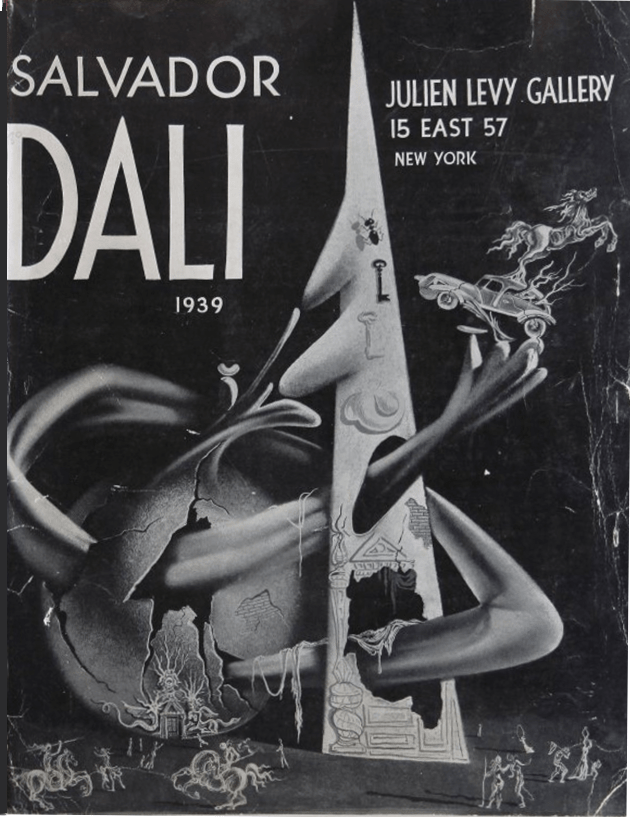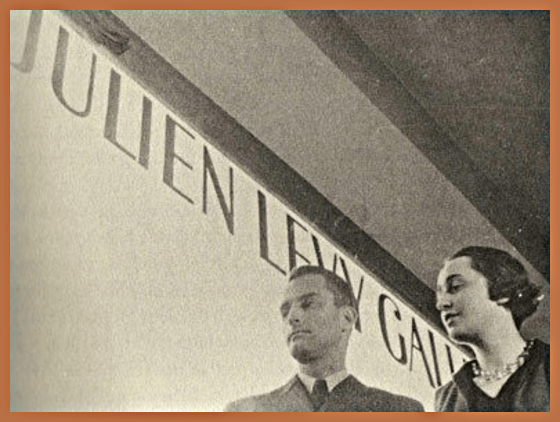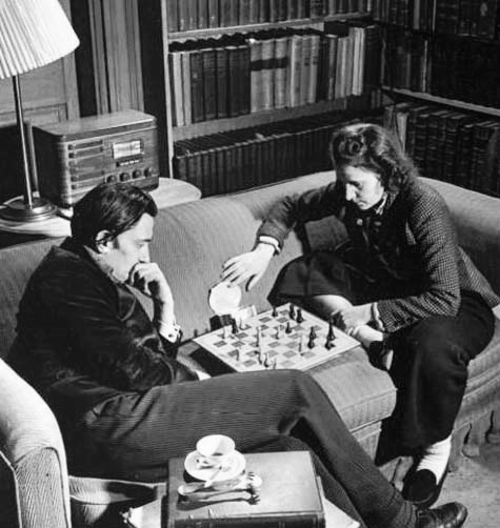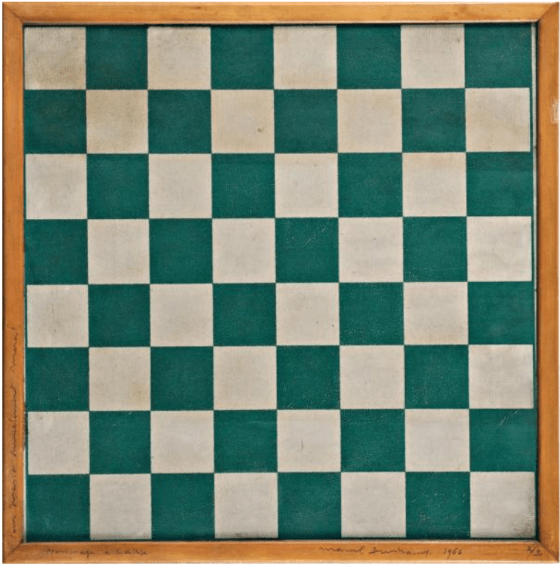
The Julien Levy Gallery
Chess as Art had been debated over and over. Whether or not Chess is Art, there does seems to be some affinity between the two disciplines. Marcel Duchamp, a devotee to both, explained that it was the complexity inherent in each that formed the bridge. Whatever the case, it's intriguing to observe the interplay between art and chess on its many levels.
Due in large part to Marcel Duchamp, the most intense connection between chess and artists took place among the Dadaists and Surrealist artists during the first half of the 20th century. Julien Levy was one of the most important advocates of Surrealism and his gallery gave exposure to the greatest of these artists. In a sort of game-within-a-game, the interaction between the artists themselves reflected the interaction between their art and chess.
Here is a catalogue cover from the Salvador Dalí show at the Julien Levy Gallery in 1939.

The address —15 E. 57th St., New York— that once housed the Julien Levy Gallery is now the Manhattan headquarters and home of the Chanel Boutique. (The Levy Galley was originally located in the same corner but a different address —602 Madison Ave where it specialized in photography).
This is something of an irony.

Julien and his wife Joella at the opening of their gallery in Nov. 1931
In 1936 Salvador Dalí left Spain to avoid the Civil War. He spent time in New York City, in Arcachon, a coastal town near Bordeaux, France and in Bowling Green, Virginia . He stayed in Arcachon with his wife, the former Gala Éluard, Marcel Duchamp and Leonor Fini (who had also had a show of her surrealistic paintings, along with those of Max Ernst, at the Levy Gallery in 1936). At the beginning of WWII, Coco Chanel (as mentioned, the company she founded would eventually buy the building where Julien Levy had his gallery) closed her shop and fled Paris, as well as the world of haute couture, for Arcachon where she and the aforementioned group frolicked, dined out, made business connections and followed the war's development. Chanel returned to Paris shortly after the occupation, however, as things settled down somewhat.
Meanwhile, Marcel Duchamp found a strong chess partner in Gala while at Arcachon.
Salvador Dalí played chess daily with his wife in Arcachon. He wrote:
“Gala and I used to play chess every afternoon, at the same time that I was in the process of painting the slices of bread. I was trying to make the surface on which the rough crumbs of bread were placed very smooth. Often there were things scattered about on the floor for instance, the pawns.
One day, instead of putting them all back in the box, one of the pawns remained placed in the middle of the model of my still life. Afterwards we had to find another chess set in order to continue our games, because I was using this one and would not allow anyone to remove it.”
The still life was eventually named, "Two Pieces of Bread Expressing the Sentiment of Love." The crumbs supposedly represent the Dalí couple while the pawn represents Marcel Duchamp.

 Gala, Dalí and Leonor Fini in Arcachon, 1940
Gala, Dalí and Leonor Fini in Arcachon, 1940
[Leonor Fini was also invited to participate in the somewhat infamous "Exhibition by 31 Women" held in January 1943. Instigated, of course, by Marcel Duchamp it was hosted at Peggy Guggenheim's Art of This Century Gallery on 30 West 57th Street in Manhattan which she opened on October 20, 1942. This exhibition took a chessic turn in my mind, inspiring me to write:
https://www.chess.com/blog/batgirl/what-girls-dreams-are-made-of ]
Dalí wasn't much of a chess player compared to his contemporary surrealists and he seemed to engage in the game for the sake of Gala and Duchamp.

Dalí playing chess with his wife Gala at Hampton Manor, Bowling Green, Va. in Feb. 1941.
The caption- not shown here- read "Gala always wins."
(The Hampton House Manor, owned at the time by art patroness Caresse Crosby, had actually been designed by Thomas Jefferson but was built by Daniel DeJarnette in 1835).
In 1964 Dalí created his infamous "finger chess set."
He first made plaster casts, then had them recast them in silver and gold. The King and Queen were cast respectively from Salvador's and Gala's thumbs. Each of these were crowned with Dalí's actual childhood tooth. All the pawns were cast from the end of Dalí's thumb while the Knights were cast from the remaining part of his thumb. Inexplicably, the Rooks were cast from the salt and pepper shakers Dalí used in his room at the St. Regis Hotel in New York and topped with a mold of Dalí's nipple . The recasting was performed by the F. J. Cooper Jewelers of Philadelphia. Only 13 sets are known to exist today.



A UPI newspaper photo from Feb. 1971
In 1966, the set sold at the exhibition for $3042. In 2008, a set was auctioned off for $23,400.
A set sold in 2016 for $18,600.
 A 1978 ad for one of Dalí's casted sets -a run of 165 copies at $7,500 ea.
A 1978 ad for one of Dalí's casted sets -a run of 165 copies at $7,500 ea.
The reason for the creation of the chess set goes back, of course, to Marcel Duchamp.
In 1959 Duchamp became an officer (Chairman of the Art Committee for American Chess)
of the American Chess Foundation (the precursor to Chess-in-the-Schools which formed in 1986). He took his position quite seriously and became a formidable fundraiser, creating his own internal fund, "The Marcel Duchamp Fund for the American Chess Foundation"

from the " California Chess Reporter," April 1955 - thanks to Kerry Lawless
Duchamp had held an auction in 1961. He held a show at the galley of Daniel Cordier & Michael Warren, Inc. at 978 Madison Ave. on May 9-10 followed by an exhibition and auction at the Parke-Bernet Galleries, Inc. at 980 Madison Ave. on May 13-18, consisting of contributed artworks by various artists. He raised $81,930 for the ACF ("The Artist and His Critics Stripped Bare," by Paul Franklin).
In 1966 Duchamp organized another fundraising exhibition called "Hommage à Caissa." He invited 36 artists to contribute. It was in this show , held at the gallery at 978 Madison Ave, as of 1962 the Daniel Cordier & Arne Ekstrom Gallery, where Dalí revealed his chess set.
Using a play on words, Dalí titled his chess set "Homage to Marcel Duchamp."

poster for the "Hommage à Caissa" exhibition
Duchamp himself created a Readymade named "Chessboard" for this exhibition. It was supposed to be a run or 30 but less than 10 were actually made.

Readymade "Chessboard"
Each one was signed and numbered. The above piece was sold at Sotheby’s London in Feb. 2002 for $492,630.
"At the opening Duchamp plays chess with Dalí . While Niki Ekstrom has invited top model Benedetta Barzini, who is wearing a long, sleeveless, tiger-patterned dress, Andy Warhol has brought Velvet Underground to the opening- "Andy's coming to this show was like a guerrilla attack," comments Nat Finkelstein, who was at the gallery to take photographs while Warhol filmed Duchamp." —"Effemeridi su e intorno a Marcel Duchamp e Rrose Sélavy" Marcos y Marcos, 1993.
Bill Wall informs us that with this exhibition "Duchamp raised over $32,000 to support the American Chess Foundation."
Andy Warhol has actually expected to be invited to exhibit but for some reason was overlooked. He did, however, attend and filmed Duchamp in one of his famous "Screen Tests."
Here are Warhol's short film (Filmed Feb. 7, 1966):
https://www.youtube.com/watch?v=Z1OloAArndM
"It was very curious; I had a girl on my knees. In short, almost; a very mimosa little actress [Benedetta Barzini] came to sit next to me, rubbing herself, almost lying on me." —spoken by Marcel Duchamp, "Marcel Duchamp" by Bernard Marcadé
 Benedetta Barzini and Duchamp, 1966
Benedetta Barzini and Duchamp, 1966

 Contact sheets by Nat Finklestein, Warhol's official photographer
Contact sheets by Nat Finklestein, Warhol's official photographer
top- Warhol prepares to film Duchamp
bottom - Warhol filming Duchamp (with Barzini}
Warhol also filmed a "Screen Test" of Dalí:
https://www.youtube.com/watch?v=xaj6d9gEXAs
An interview with Anatoly Karpov, conducted by Dmitry Sokolov of the Russian magazine “Sobesednik,” talks about his meeting with Salvador Dalí at a New York restaurant in 1979.

Karpov and Dalí conversed in English. Karpov was 28 at the time; Dalí was 74. Ironically, Dalí was an artist interested in chess and asked Karpov some technical questions on the game and Karpov was a chess player interested in art, claiming he owned an extensive collection of Dalí 's works. Since Gala Dalí (born Elena Dyakonova) was from Russia, Karpov said he expected Dalí to have many questions about Russia, but he didn't. Karpov noted that Dalí was accompanied by two gorgeous women while he himself was accompanied by a KGB agent.

 Notice that in 1944 Levy's Gallery had re-located to 42 E. 57th St. NYC.
Notice that in 1944 Levy's Gallery had re-located to 42 E. 57th St. NYC.
Coming full circle:
The Julien Levy Galley is most renowned in chess circles for its 1944-45 "Imagery of Chess" Show organized by Marcel Duchamp. Those interested in the story behind the show, the show itself or just the photos memorializing it, can read all about it HERE.
Just a lagniappe...

The left image shows the Dalí Theatre and Museum in Catalonia. Dalí commissioned it and is buried there. He even lived in its tower during the last few years of his life. The little "dots" of the walls are bread-crumb shapes.
The image on the right is the former Chess Hall of Fame in Miami (the Sidney Samole Museum and World Chess Hall of Fame). It is now home to a medical equipment manufacturer.
A tiny bit of CHoF history can be read here: https://www.chess.com/forum/view/general/before-st-louis
While almost certainly unintended, the facades of the two buildings bear a noticeable, one might even say surrealistic, visual resemblance.



